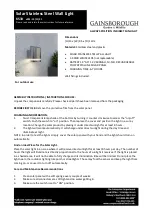
What harm can a Class 3B Laser cause?
Class 3B laser devices can be harmful to eyesight if viewed directly. i.e. that is, the beam or effect
strikes the face of a person. The actual injury that a Class 3B laser can cause depends upon a
number of factors, including how long the laser beam enters the eye for, the intensity of light, and
what part of the eye it actually gets focused onto. The most susceptible part of the eye to receive
damage from a laser is the internal back wall of the eyeball, known as the retina. It is this part of
the eye that receives the light signals that are sent to brain. All light entering the eye gets focused
onto the retina.
Normal light sources such as traditional light bulbs and regular lighting effects are normally not
harmful to view. Lasers differ in that they can get focused down to very small points on the retina
that can literally burn holes on the back of the eye, which can lead damage to eyesight. This
process can happen in less time than it takes for a person to blink. There are no pain receptors
on the retina, so the person will be unaware of any damage taking place. Damage caused to the
retina is permanent, and can vary from unnoticeable loss of vision, through to severe loss of sight,
particularly if the damage occurs in the part of the retina that senses the central vision.
Are there any laws or licences relating to using Class 3B lasers?
There are no specific “laser licences” that anybody needs in order to own or operate a laser for
lightshow use. However, there is specific guidance issued by the Health and Safety Executive in
the form of a document called HS(G)95 The Radiation Safety of Lasers Used for Display
Purposes. HS(G)95 outlines a number of detailed points to consider when using lasers for
lightshow purposes.
Furthermore, since April 2010 new health and safety legislation was introduced in the UK that sets
legal limits as to the amount of laser light a person may be exposed to in the workplace. Class 3B
lasers have the ability to exceed the safety limits. The full title of the laser safety regulations is the
Control of Artificial Optical Radiation at Work Regulations 2010, which also define the need for risk
assessment of the exposure levels.
Most places of public entertainment operate under a Public Entertainments Licence, which is
issued by the Local Authority. The entertainment licence requirements will normally need to have a
specific provision covering the use of lasers at the venue, where it is expected that the laser instal-
lation, (whether temporary or permanent), is to operated in compliance with the HS(G)95 laser
safety guidance as part of the venue’s Public Entertainment Licence conditions.
The use of lasers, as any other equipment used for shows, will also be covered by more general
health and safety legislation, such as the Health & Safety at Work Act 1974, and the Management
of Health and Safety at Work Regulations 1999, etc. These regulations, among other things, state
that you must ensure the safety of people present at the event where the laser is used, and also
that a suitable risk assessment regarding the use of laser must be carried out.
Equinox Lexor Laser
Safety



































